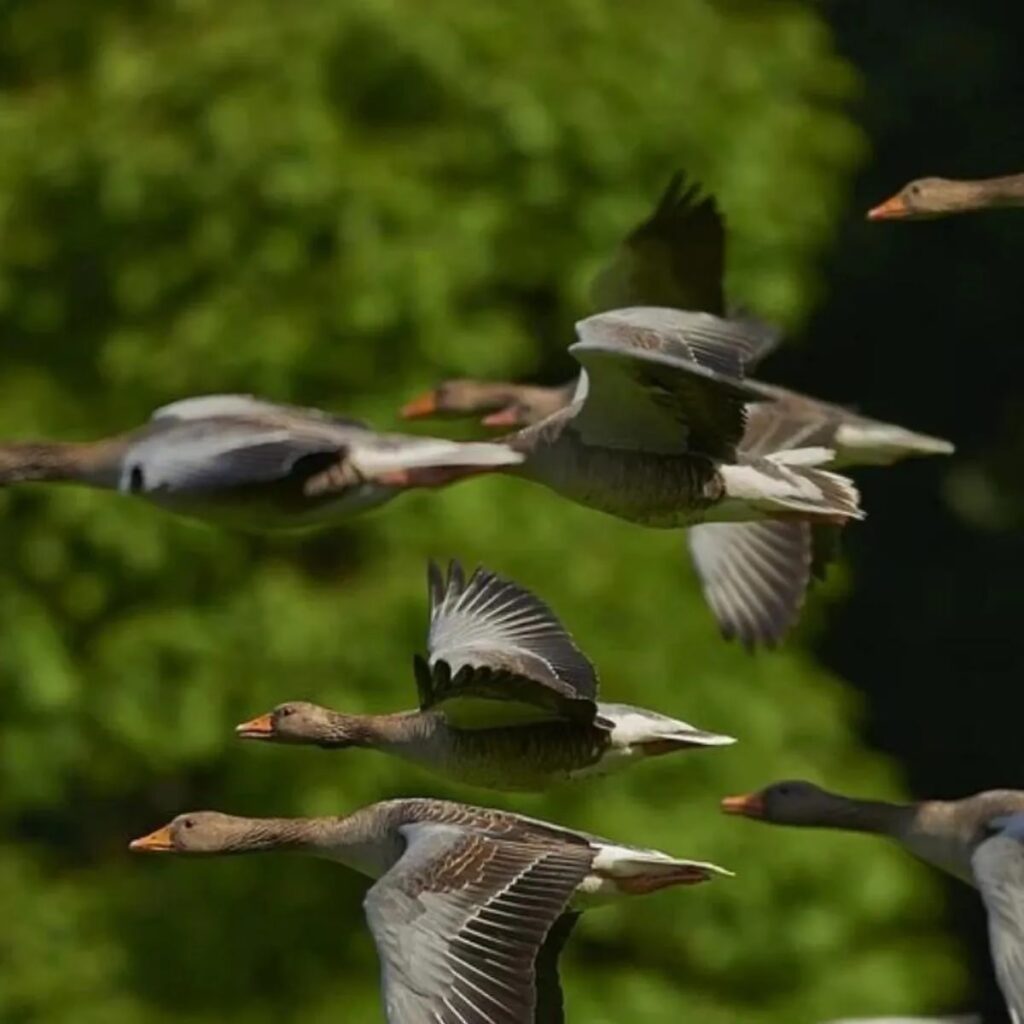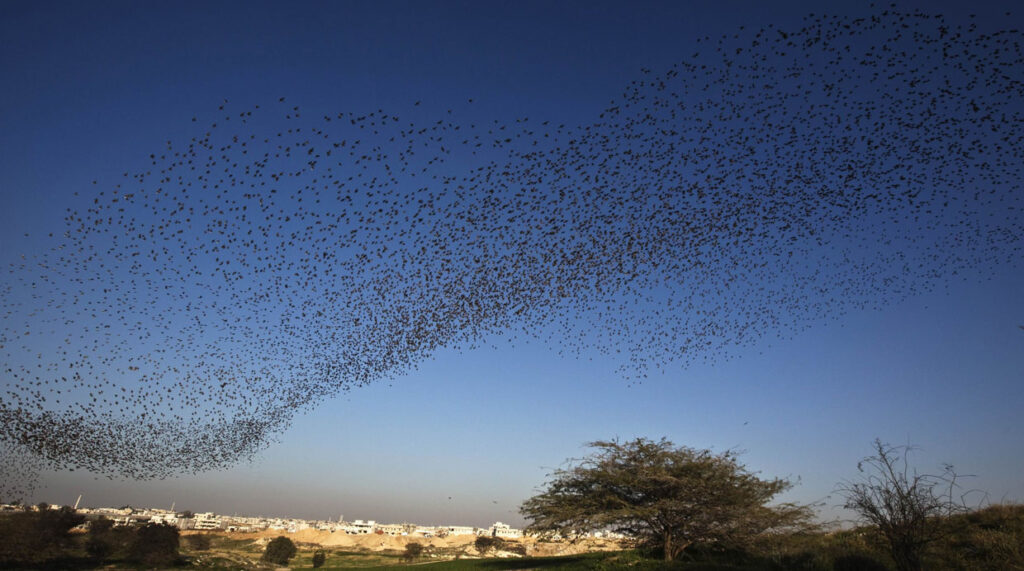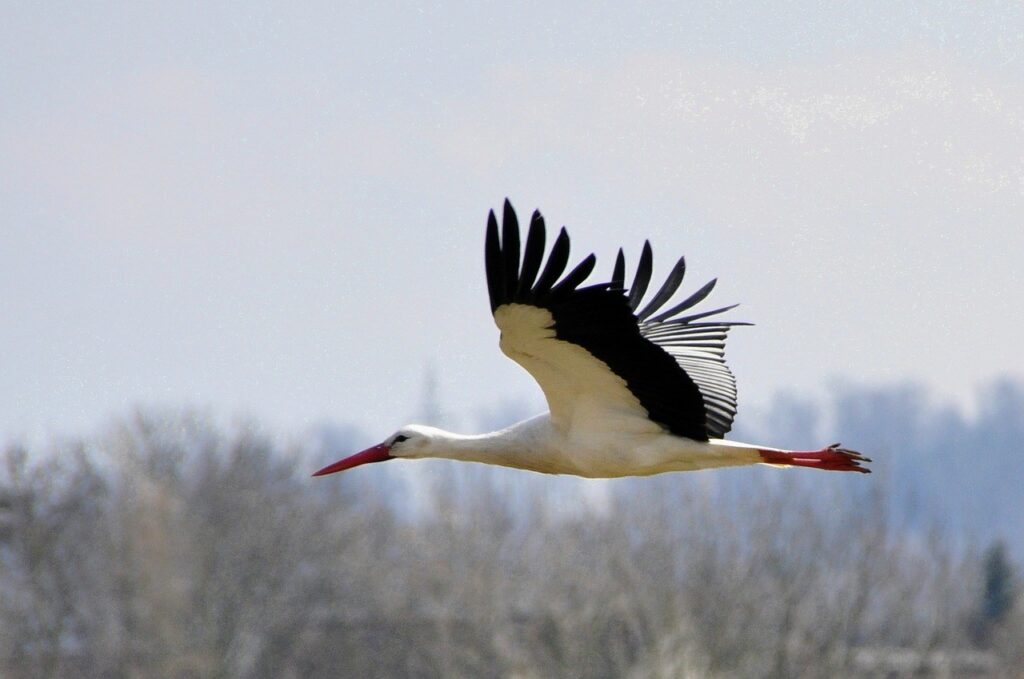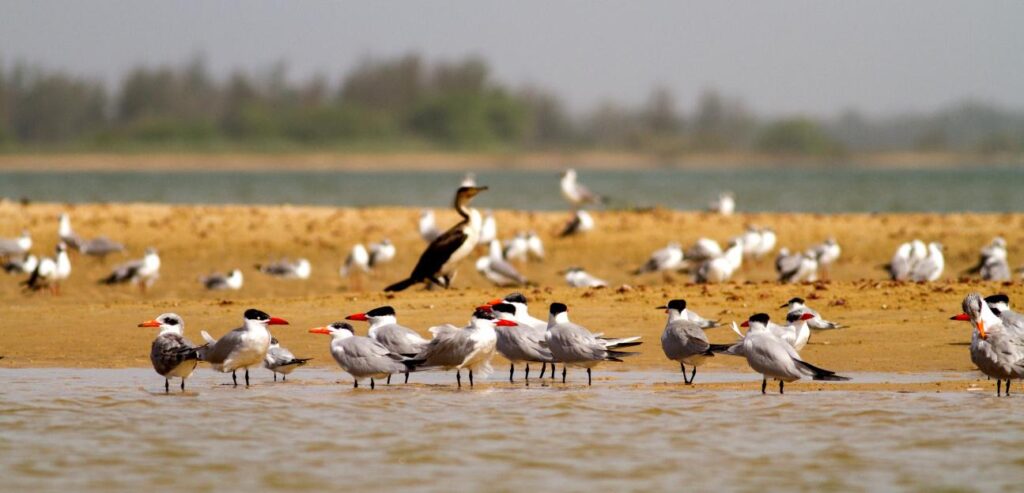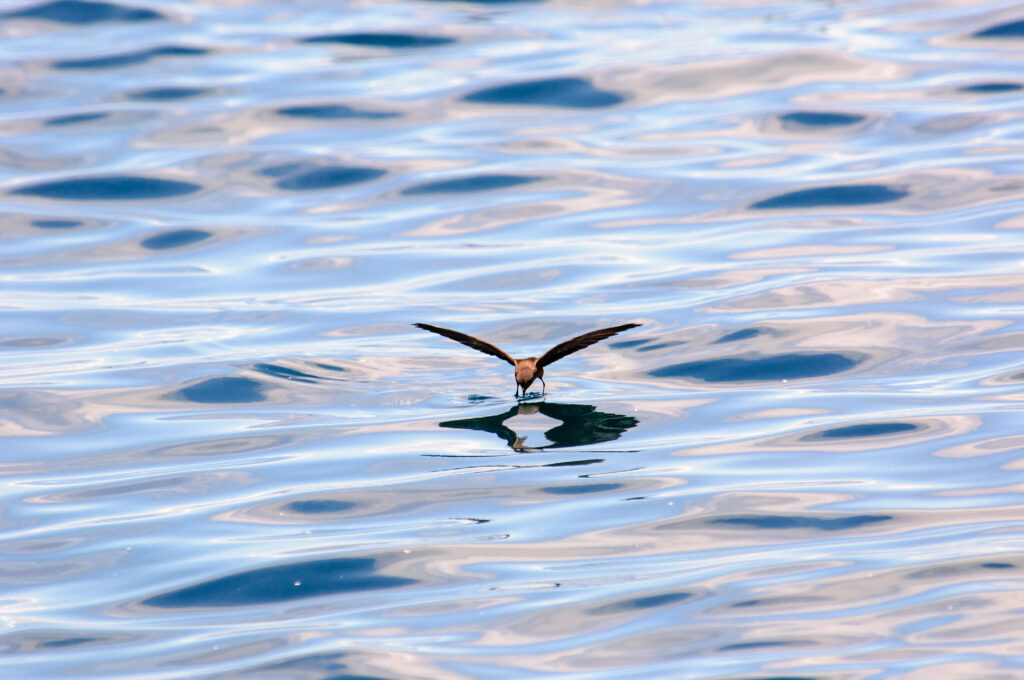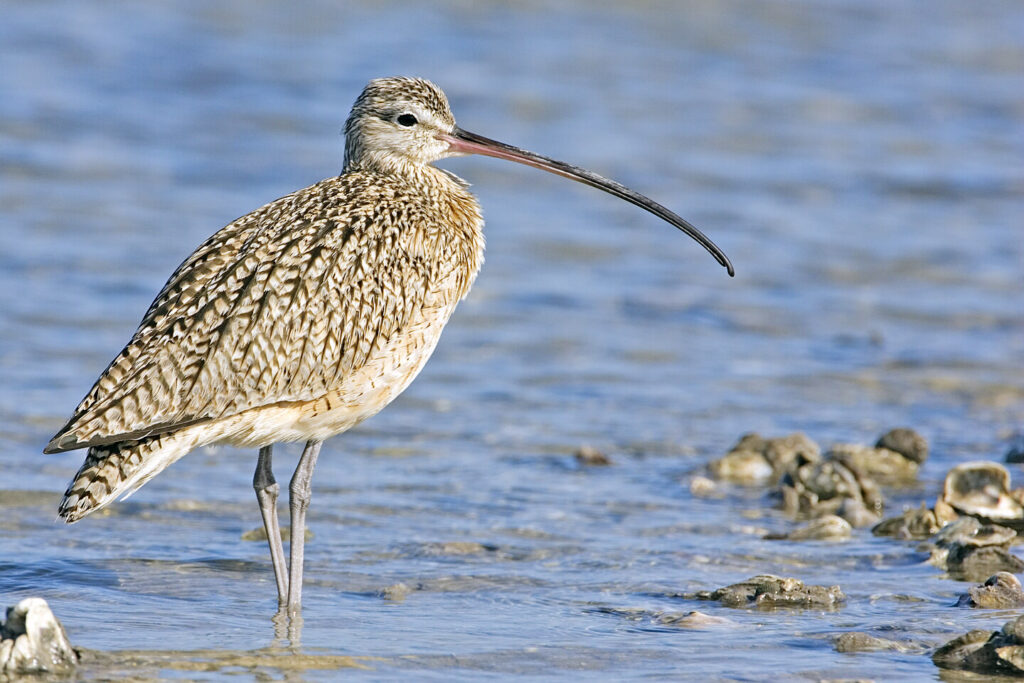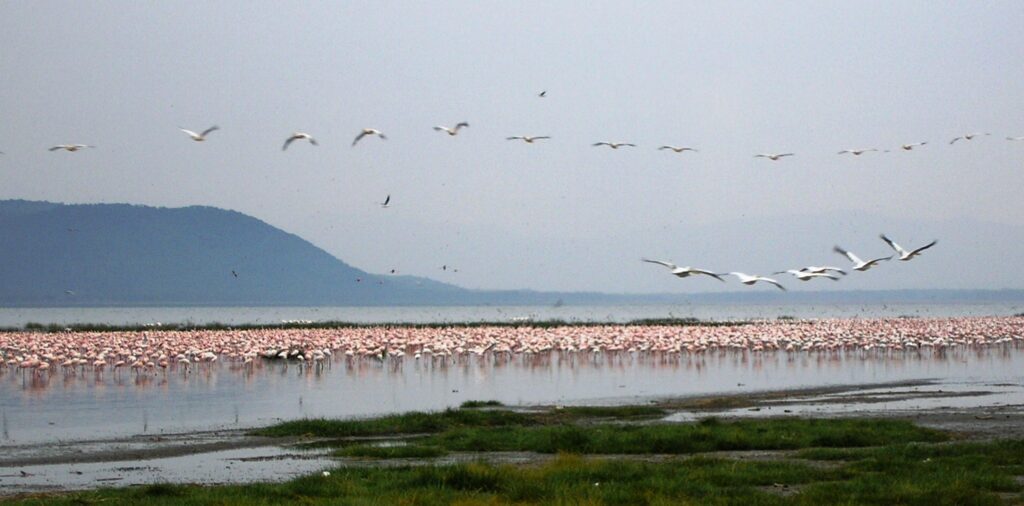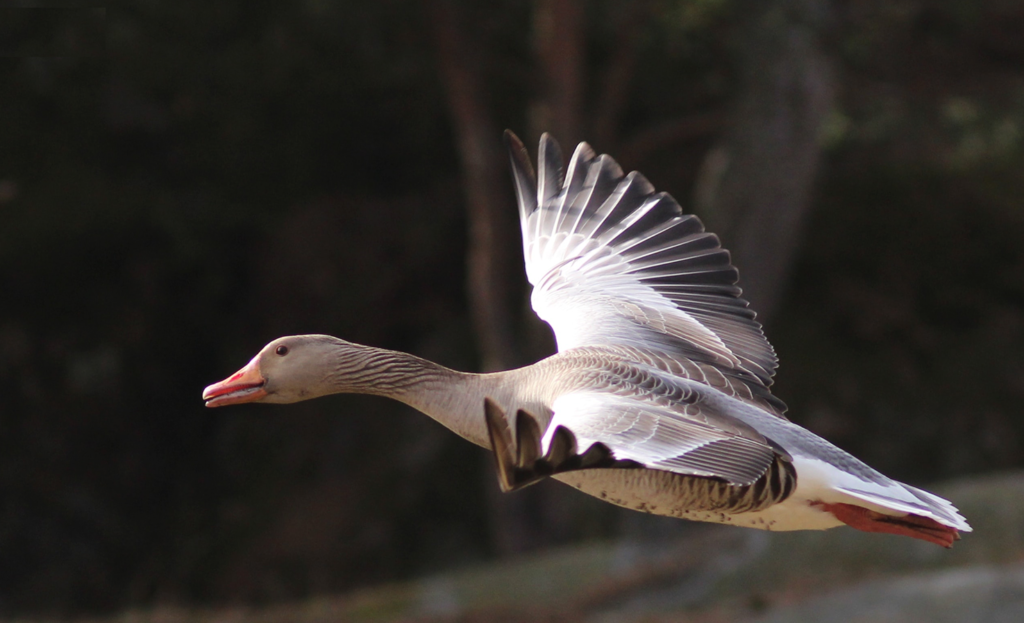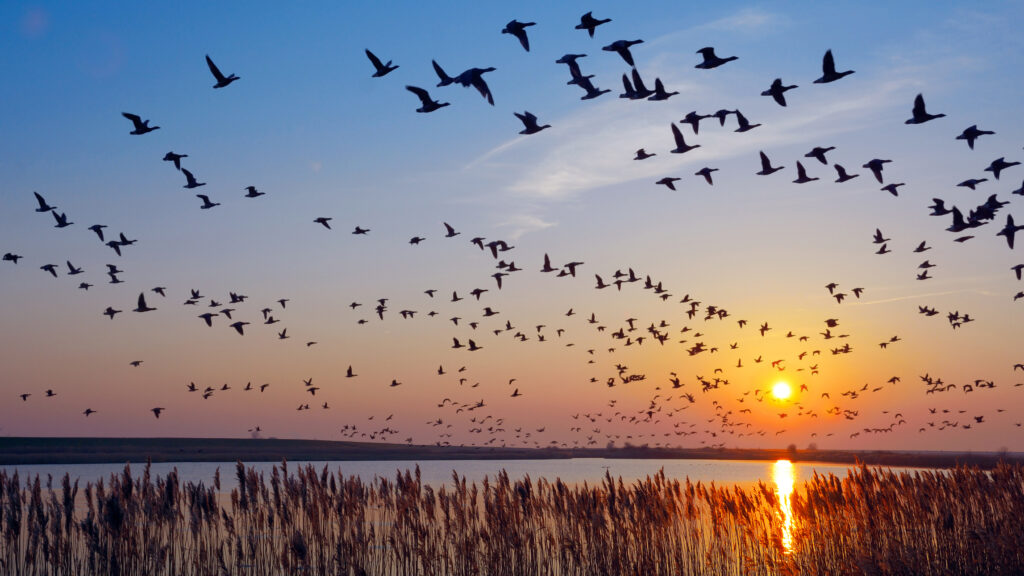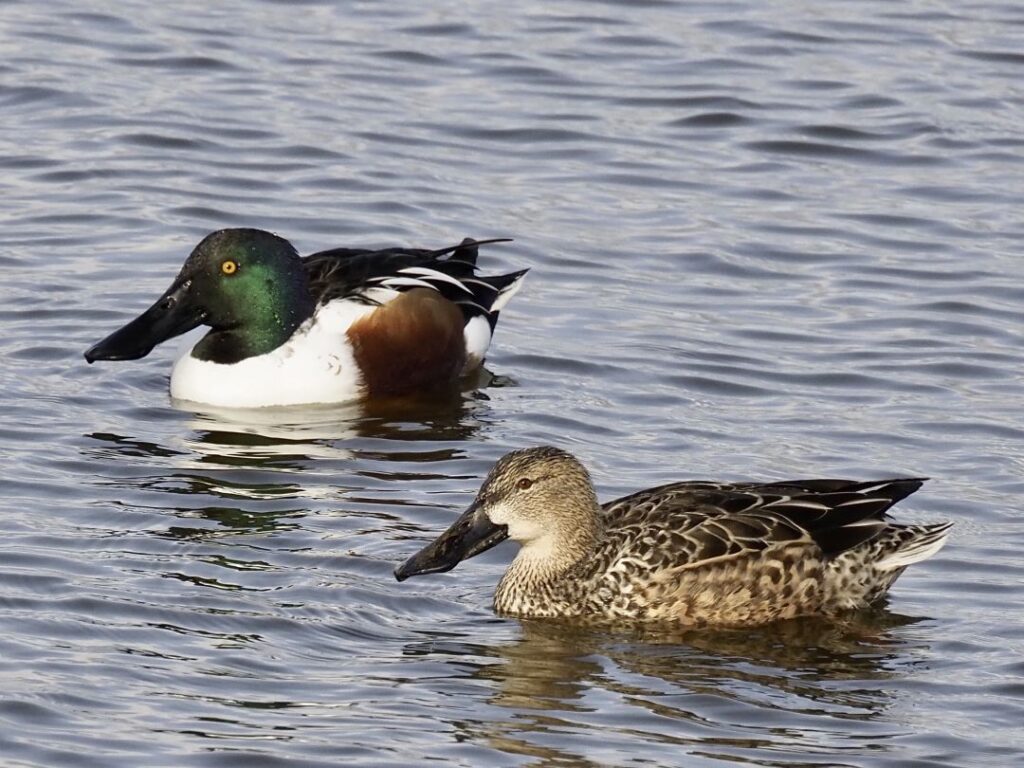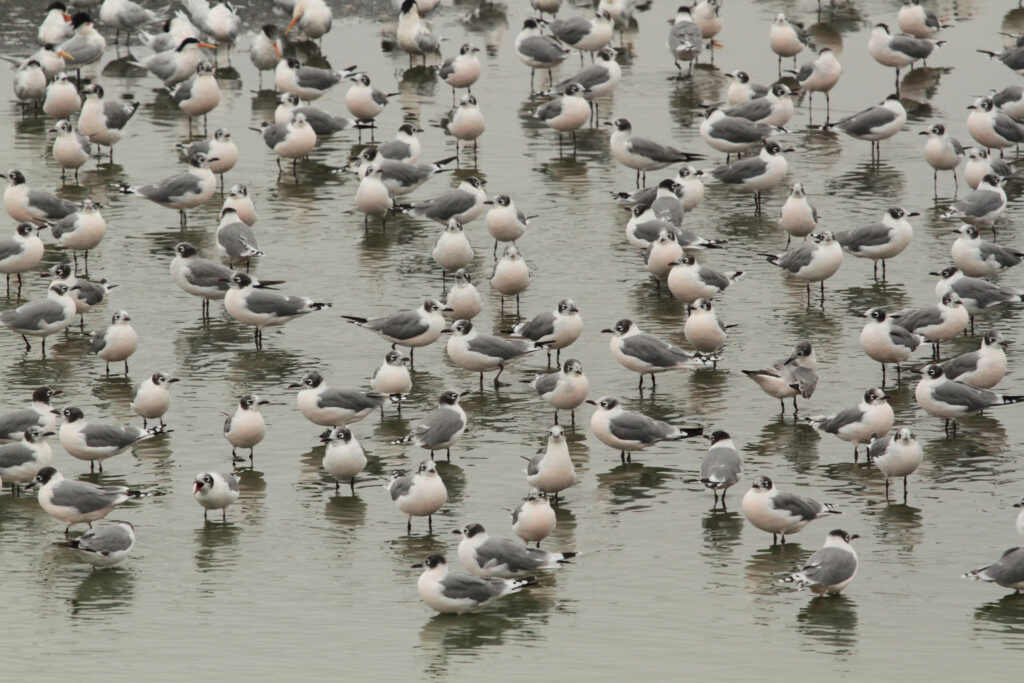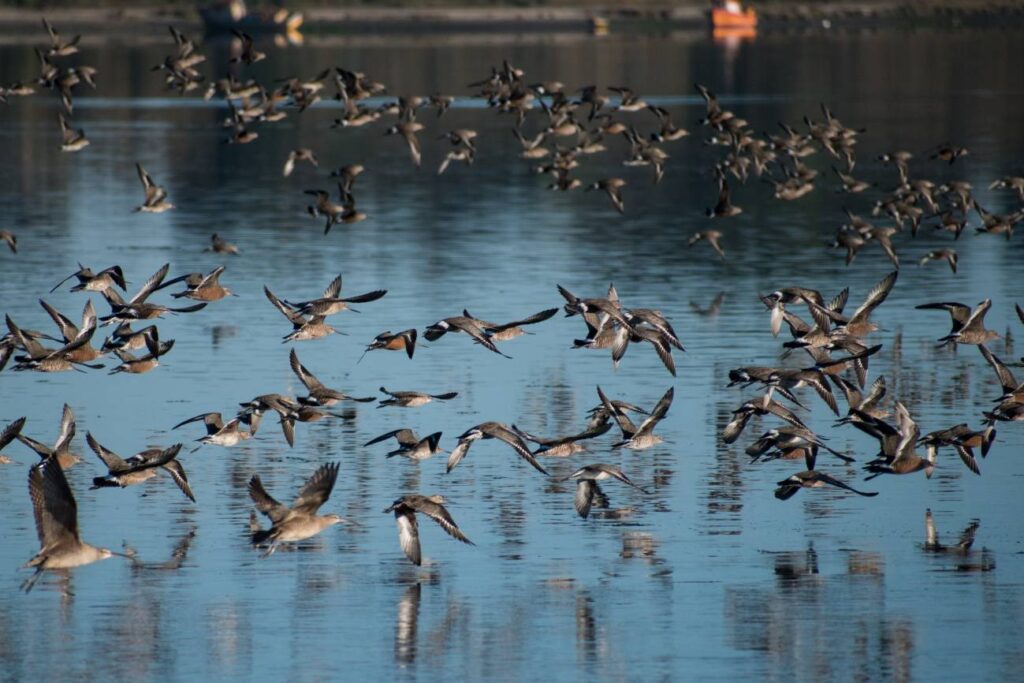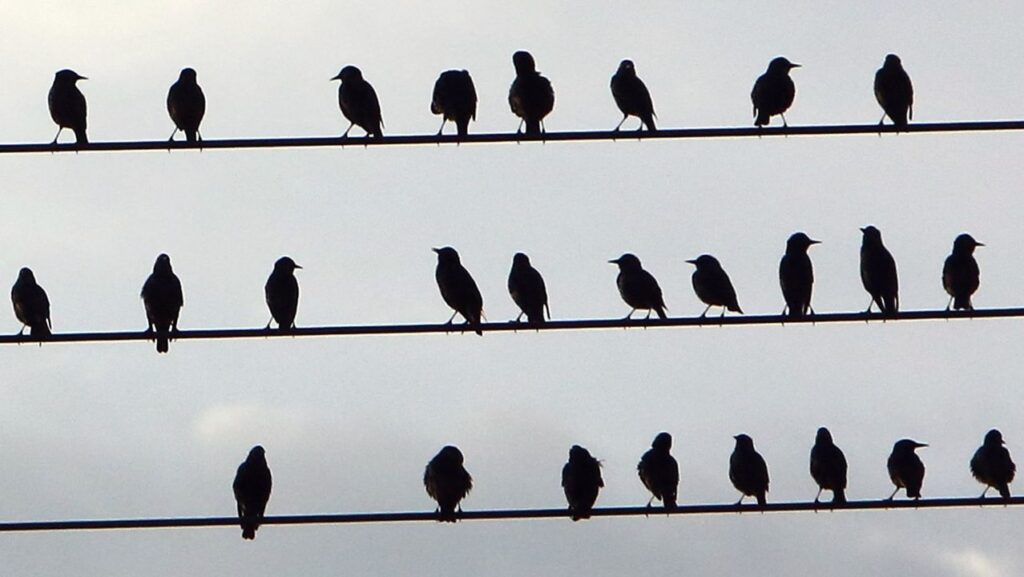Migratory birds are a very frequent event in nature and thanks to their ability to fly they can cover enormous distances with few or no stops to refuel and replenish energy. The impulse that leads them to engage in these adventures is to avoid winter, the search for food or the achievement of a mate and subsequent breeding.

migratory birds
It is called bird migration to the process that includes the trips that numerous species of birds make in each season and on a regular basis. In addition to migration, birds carry out other movements in reaction to alterations in the existence of food, habitat or climate, which are usually irregular or only in one direction and are called in different ways such as nomadism, invasions, disseminations or incursions. . In contrast, birds that do not migrate are called resident birds.
General Patterns
Migration is determined by its occurrence in the same season each year. Many land birds migrate great distances. The most frequent patterns involve moving north to breed in the summers in temperate or arctic areas and returning to wintering regions in warmer southern territories.
The primary circumstance that most favors migration is energy. The longer days of summer in the north provide more opportunities for breeding birds to feed their chicks. The lengthening of daylight hours enables diurnal birds to spawn larger clutches than those of related non-migratory varieties that remain in the tropics year-round. Just as the days get shorter in the fall, the birds return to warmer regions where the existing food supply changes little with the season.
These advantages outweigh the risks of high stress, energy cost, and other dangers of migration. Predation may be higher during migration. The Eleonora's falcon (Falco eleonorae), which breeds on the Mediterranean islands, has a very delayed breeding season, synchronized with the autumn passage of the birds that migrate south, with which it feeds its chicks. A similar strategy is adopted by the bat Nyctalus lasiopterus, whose food is migratory birds.
Large concentrations of birds migrating at temporary stopovers also make them prone to parasites and pathogens, necessitating a higher immune response. Within a given species, not all populations have to be migratory, which is called partial migration. Partial migration is very frequent in the southern continents; in Australia, 44% of non-passerine and 32% of passerine bird varieties partially migrate.
In certain species, the population of higher latitudes is usually migratory and will often hibernate at lower latitudes than those in which the other populations of the same variety are sedentary and, therefore, have already occupied that suitable habitat for wintering, since this is called "frog-hopping migration".
In a population, there may also be a distinct pattern of chronology and migration based on age and sex groupings. Only female Fringilla coelebs (Chaffinches) in Scandinavia migrate and the males remain residents (this gave rise to the name coelebs, meaning single). Most migrations begin with the birds rising in a large front. In certain cases, migration involves narrow migration belts that are established as traditional routes called migratory flight routes.
These typically follow mountain ranges and coastlines, and can take advantage of breezes and other wind patterns or bypass geographic obstacles such as large bodies of open water. Particular pathways may be programmed into their genes or learned to varying degrees. The routes they take in one direction and the return are often different.
Most of the larger birds fly in flocks. This type of flight helps them reduce energy consumption. Many of them fly in a V formation and individual energy savings have been estimated at 12-20%. The sandpiper Calidris canutus (fat sandpiper) and Calidris alpina (sand sandpiper) were tracked by radar study in which it was determined that they flew 5 kilometers per hour faster in flocks than when they did so alone.
The elevation to which birds move on migrations is variable. An excursion to Mount Everest yielded skeletons of Anas acuta (north-tailed duck) and Limosa limosa (black-tailed woodpecker) 5.000 meters above the Khumbu Glacier. Geese Anser indicus have been seen flying over the highest peaks of the Himalayas above 8.000 meters, even when lower passes of 3.000 meters were nearby.
Seabirds fly low over water but gain height by crossing over land and a reverse behavior can be seen in land birds. However, most bird migrations take place in the 150 meter range. at 600 meters. Records of bird strikes in the United States found that most strikes occur at altitudes below 600 meters and almost none above 1.800 meters.
Most varieties of penguins make regular migrations by swimming. These routes can cover more than 1.000 kilometers. The Cock of the Rockies (Dendragapus obscurus) performs altitude migrations mostly by walking. Emus in Australia have been seen making long distance walks in times of drought.
Historical Vision
The initial observations that registered the migration of birds are from about 3.000 years ago, referred to by Hesiod, Homer, Herodotus, Aristotle and others. The Bible also cites migrations, as in the Book of Job (39:26), in which the question is asked: "Is it because of your talent that the falcon covers itself with feathers and spreads its wings to the south?" The prophet Jeremiah (8:7) reported: «Even the stork in the sky knows its seasons; the turtle dove, the swallow and the crane know the time to migrate«.
Aristotle relates that the cranes move from the Scythian plains to the swamps at the headwaters of the Nile. Pliny the Elder in his "Naturalis Historia" reiterates what Aristotle observed. On the other hand, Aristotle argued that swallows and other birds hibernated. This conviction was maintained even until 1878, date in which Elliott Coues made a list of at least 182 works concerning the hibernation of swallows.
It was only at the beginning of the XNUMXth century when migration was admitted as the cause of the disappearance of birds in the winter season in northern climates. The discovery of white storks in Germany, which were injured by African arrows, provided clues about the migration. One of the oldest arrowed specimens was located near the German village of Klütz in the state of Mecklenburg-Vorpommern.
Long Distance Migration
The traditional image of migration is made up of northern land birds such as swallows and birds of prey making long flights to the tropics. Numerous ducks, geese, and swans that breed in the north are likewise long-distance migrants, yet would need to travel south only as far as necessary to avoid the waters beginning to freeze in their arctic breeding regions.
Most of the Holarctic varieties of Anatidae remain in the northern hemisphere, but in nations with more temperate climates. As an example, Anser brachyrhynchus (short-billed goose) makes its migration from Iceland to Great Britain and nearby countries. Migration routes and wintering areas are typical and learned by the young through their initial migration alongside their parents. Some ducks, such as Anas querquedula (carretota teal), move wholly or partially to the tropics.
The same considerations about impediments and detours that apply to migrating land birds for long distances, are typical of water birds, but to the contrary: a large territory of land without aquariums that provide a place to feed is an obstacle for a water bird. The open sea is also a barrier for a bird whose food is found in coastal waters.
Detours are made to circumvent these barriers: for example, Branta bernicla (collared goose) traveling from the Taimir Peninsula to the Wadden Sea (Holland, Germany and Denmark) moves along the White Sea and Baltic Sea littoral route instead of directly crossing the Arctic Ocean and northern Scandinavia.
A similar situation occurs with wading birds (Charadriiformes). Numerous species such as Calidris alpina (common sandpiper) and Calidris mauri (Alaskan sandpiper) make long journeys from their breeding areas in the Arctic to warmer places in the same hemisphere, but others such as Calidris pusilla (semipalmated sandpiper) travel immense distances to the tropics.
Like the large, vigorous ducks and geese (Anseriformes), waders are extraordinary fliers. This means that birds wintering in temperate zones have the ability to make short extra movements in the event of very inclement weather.
For some waders, successful migration will depend on the availability of essential food resources at stopover sites along the entire flyway. This provides migrants with an opportunity to refuel for the next leg of the journey. Some examples of important immigration detention sites are the Bay of Fundy and the Delaware Bay.
Some specimens of Limosa lapponica (snipe or Bar-tailed Woodpecker) hold the record for the longest non-stop flight ever recorded for a migratory bird, traveling 11.000 kilometers from Alaska to their non-breeding seasons in New Zealand. migration, 55 percent of your body weight is fat that you have stored to power this non-stop journey.
Seabird migration is similar in pattern to that of Charadriiformes and Anseriformes. Some, like Cepphus grylle (white-winged guillemot) and certain gulls, are very sedentary, while others, like most terns and razorbills that breed in temperate areas of the northern hemisphere, move varying distances to the south. throughout the winter.
The longest migratory route of all birds is made by Sterna paradisaea (Arctic tern) and it stays in daylight longer than any other bird, moving from its breeding grounds in the Arctic to the Antarctic region throughout the season. non-reproductive. An arctic tern, which was given an identification ring as a chicken in the Farne Islands, located far from the British eastern coast, arrived in Melbourne, Australia, in just three months after fledging; a sea voyage of 22.000 kilometers.
Some seabirds, such as Oceanites oceanicus (Wilson's pamperito) and Puffinus gravis (Capirotada shearwater), breed in the southern hemisphere and move north in the austral winter. Seabirds have the additional advantage of being able to obtain food throughout their migration over open water.
The more pelagic varieties, primarily Procellariiformes, are great vagrants, and southern ocean albatrosses may fly around the globe in the non-breeding season. Procellariiformes birds are widely scattered over considerable areas of open ocean, but gather when food is available.
Many are also found among long-distance migrants; Puffinus griseus (shearwater or dark pamperito) that nest in the Malvinas Islands fly 14.000 kilometers between the breeding territory and the North Atlantic Ocean off Norway. Some Puffinus puffinus (Manx Shearwater) make this same journey in reverse. Being birds that live a long time, they can accumulate great distances traveled, which in one specimen were estimated at about 8 million kilometers throughout its verified life of more than 50 years.
Certain large, wing-spreading birds are dependent on rising plumes of warm air to enable them to glide. These include numerous birds of prey such as vultures, eagles and sparrowhawks, as well as storks. These birds perform their migration during the day.
It is difficult for the migratory birds of these groups to cross large bodies of water, since the thermal columns are only formed on land, and these birds cannot sustain active flight for long distances. The Mediterranean and other seas are therefore important obstacles for soaring birds, which are forced to cross through the narrowest points.
A considerable mass of huge birds of prey and storks cross through areas such as Gibraltar, Falsterbo and the Bosphorus in migration season. The most frequent species, such as Pernis apivorus (Honey Buzzard), number in the hundreds of thousands in autumn. Other impediments, such as mountain ranges, can also cause huge concentrations, especially of large diurnal migrants. This is a notorious element in the bottleneck for migration from Central America.
Many of the more modest insectivorous birds, including warblers, hummingbirds, and flycatchers, migrate long distances, usually at night. They rest throughout the morning and feed for a few days before continuing their migration. The birds are called “in transit” in the areas in which they make their appearance temporarily in brief stays throughout the migratory journey.
By migrating at night, nocturnal migrants reduce the danger of predators, and avoid overheating that could be caused by the energy consumed throughout the flight in such long distances. This also enables them to feed during the day to restore energy for the night. Migrating at night comes at the price of lost sleep. Migrants must be able to achieve impaired-quality sleep throughout the flight to compensate for this loss.
Short Distance Migration
Many of the long-distance migrants in the previous section are effectively programmed in their genes to react to variable day length. However, many species move shorter distances, but they do so only in response to difficult weather conditions.
In such a way that those that have their reproduction in peaks and moors, such as Tichodroma muraria (wallcreeper) and Cinclus cinclus (dipper), can barely move in altitude to avoid the cold highlands. Other varieties such as Falco columbarius (merlin) and Alauda arvensis (skylark) move a little further, towards the coast or to a more southern area. Species such as Fringilla coelebs (Chaffinches) are not likely to migrate in Britain, but will move south or to Ireland if the weather is very cold.
Short-distance passerine migrants have two evolutionary origins. Those with relatives that migrate long distances within the same family, such as Phylloscopus collybita (Chiffchaff), which are native southern hemisphere varieties that have gradually shortened their return journey to stay in the northern hemisphere.
Species that do not have extensive migratory relatives in their family, as in Bombycilla, move only in reaction to the winter season, rather than to expand their reproductive opportunities. In the tropics there is little variation in the length of daylight throughout the year, and it is always warm enough for a proper food supply. Apart from the seasonal movements of the wintering varieties of the northern hemisphere, a large part of the species move variable distances according to the rainfall.
Many tropical areas have wet and dry seasons, the Indian monsoons being perhaps the best known example. A bird specimen whose distribution is related to rainfall is the arboreal kingfisher Halcyon senegalensis (Senegalese Kingfisher) from West Africa. There are a few varieties, most notably the cuckoos, which are genuine long-distance migrants within the tropics. One model is Cuculus poliocephalus (cuckoo or lesser cuckoo), which breeds in India and spends the non-breeding season in Africa.
In the high mountains, such as the Himalayas and the Andes, there are also seasonal elevational shifts in numerous species, and others can make long-distance migrations. Ficedula subrubra (Kashmir flycatcher) and Zoothera wardii (Ward's thrush), both from the Himalayas range as far south as the highlands of Sri Lanka.
Irruptions and Dispersion
Sometimes conjunctures such as a favorable breeding season followed by a lack of food resources in the next year lead to a breakthrough, where large numbers of a species move far beyond their usual range. Bombycilla garrulus (European Waxwing), Carduelis spinus (Sispon), and Loxia curvirostra (Common Crossbill) are varieties that exhibit this unpredictable alteration in their numbers each year.
The temperate regions of the southern continents have large arid zones, especially in Australia and western southern Africa, and climate-driven shifts are frequent but not always predictable. A couple of weeks of heavy rain in one area or another of regularly dry central Australia, for example, causes plant and invertebrate overgrowth, attracting birds from far and wide.
This can happen in any season of the year, and, in any defined area, it may not happen again for ten years or more, since it depends on the frequency of “El Niño” and “La Niña” periods. Bird migration is an event that takes place primarily, though not entirely, from the Northern Hemisphere. In the southern hemisphere, seasonal migration is usually much less overt, and for which there are various reasons.
In the first place, large land masses or oceans, without major obstacles, usually do not concentrate migrations through narrow and obvious routes, and therefore, a human observer is less aware of it.
On the other hand, at least for land birds, climatic zones usually fade into one another over enormous distances rather than being completely separate: this means that instead of making a long trek over unsuitable habitat to reach a specific destination, migratory varieties can usually move slowly and leisurely, foraging for food as they go.
Without sufficient ringing studies, it is not evident in these cases that the birds contemplated in a particular region according to seasonal change are in fact different members of the same variety that pass progressively continuing their route north or south.
Indeed, numerous species do breed in temperate areas of the south and winter further north in the tropics. In Africa, Hirundo cucullata (Large Barred Swallow), and in Australia, Myiagra cyanoleuca (Satin Flycatcher), Eurystomus orientalis (Dollar Green Roller) and Merops ornatus (Rainbow Bee-eater), for example, winter far north of their range breeding.
Physiology and Control
The control of migrations, their determination in time and the response to them are genetically regulated and apparently they are primitive characteristics that are present even in numerous non-migratory species. The ability to independently navigate and orient through migrations is a much more complex event that includes both endogenous programs and teaching.
Physiological Basis
The physiological principle of migration includes endogenous processes, generated by external stimuli, which are received by the central nervous system (CNS). (Gwinner 1986; Ketterson and Nolan 1990; Healy et al. 1996; Birgman 1998).
As "emissaries" of the process are the neuroendocrine and endocrine hormones secreted via the hypothalamus-pituitary gland. The migratory need has a powerful genetic factor: there are experiments with yellow wagtails (Motacilla alba) in which different populations in similar geographical areas have very unequal migratory characteristics (Curry-Lindahl, K. 1958).
The migratory activity causes relevant changes in the physiology of the animal, where hyperphagia, the increase in blood hematocrit and certain behavioral changes such as gregariousness stand out.
Changes that occur in the Bird
In the premigratory stage the bird primarily increases its lipid level (Blem 1990). Fats are the most important source of energy in this process, they are stored particularly in adipose tissue, muscles and internal organs (George and Berger 1966). Among the most relevant areas of fat storage are: the clavicle, the coracoid, the sides, the abdomen, the pelvis and the buttock area (King and Farner 1965).
The fatty acids that are consumed during migratory activity (preponderance of unsaturated fatty acids) are not those used during the nesting stage (saturated fatty acids prevail) (Conway et al. 1994). As previously mentioned, fat is stored in the muscles, but not in the heart. The storage of fats in the premigratory stage has been well known for many years by gourmets who opt for those who migrate at this time because their meat is more delicate and richer in fat.
According to the distance to travel throughout the migratory process, the bird stores more or less reserves. Fats, in addition to providing energy for the muscles, contribute to the bird's thermoregulation throughout the process. During migration, the bird also increases protein and carbohydrate expenditure. In the pre-migratory stage the bird suffers from a hyperphagic process: it has been shown that also in this phase the bird has a greater capacity to restore reserves.
Neural Bases and Hormones Involved in Migratory Processes
A group of endocrine glands help define the migratory impulse. The pituitary appears in a prominent position, representing the role of control post of the organism, and also because of its sensitivity to lighting elements. In addition to the pituitary gland, the relevance of the thyroid (controls the displacement of fats in thermoregulation) and the gonads has been pointed out (Rowan, W.1939, inferred from his experiments that an intermediate gonadal development was an indispensable requirement for the migratory process).
- Environmental elements condition migratory activity, directly affecting the previously mentioned glands, for example:
- In the case of the thyroid, there are numerous incidents of birds migrating enormous distances "driven" by powerful cold waves.
- The pituitary is openly influenced by the photoperiod (time exposed to daylight), each variety breeds and migrates according to its ideal photoperiod margins. Experiments have been carried out with captive birds in which it was possible to corroborate that only with the stimulation of the photoperiod the birds showed agitation oriented to their migration sites.
Prolactin, growth hormone, pancreatic hormone, pituitary hormone, catecholamines, and insulin play essential roles in fat storage, muscle hypertrophy, and increased hematocrit (Ramenofsky and Boswell 1994).
- Catecholamines, growth hormones and corticosterone are involved in fat displacement (Ramenofsky 1990).
- Corticosterone and testosterone are of great importance in the migration of birds at night (Gwinner 1975).
- Melatonin has a substantial role in how migration and orientation are organized (Beldhuis et al. 1988; Schnneider et al. 1994).
Triggering Chronological Factor
The fundamental physiological stimulus for migration is variation in day length. These alterations are linked to hormonal changes in birds. In the period prior to migration, many birds show increased activity or “Zugunruhe” (German: migratory disturbance) as well as physiological changes such as increased fat storage.
The appearance of this phenomenon, even in captive birds without environmental stimuli (for example, shorter days or reduction in temperature), provides signs of the role of endogenous programs with annual regularity in the regulation of bird migration.
These caged birds manifest a preferred direction of flight that is consistent with the direction of migration they would have taken had they been free, even altering their preferred courses almost in unison with wild individuals of their species altering their course. In varieties in which polygyny and marked sexual dimorphism are present, there is a propensity for males to return to breeding sites sooner than females, which is called protoandry.
Orientation and Navigation
Birds are guided by various sensors. In numerous species the use of a solar compass has been determined. Using the sun to get the route implies making compensations in the variation of its position based on the time of day. Navigation has also been determined to be based on the mixture of other skills that include the location of magnetic fields, the use of visual reference marks as well as olfactory trails.
Long-distance migrant birds are thought to spread as young and become attached to potential breeding sites and preferred wintering grounds. Once the attachment to the place has been generated, they exhibit a high loyalty to the site, since they visit it year after year.
The ability of birds to navigate through migrations cannot be fully explained on the basis of endogenous programming, even with the contribution of responses to environmental stimuli. The ability to successfully migrate over long distances can possibly only be understood if the cognitive quality of birds for habitat recognition and mental mapping is taken into account.
Satellite monitoring of day-migrating raptors such as Pandion haliaetus (Osprey) and Pernis apivorus (House-hawk) has determined that older subjects are more effective at correcting course than becoming drifted by the wind. As the models with annual rhythms point out, there is a strong genetic component to migration according to timing and route determination, but this can be altered by environmental influences.
An interesting example of migratory route change caused by geographical obstacles is the propensity of some Central European Sylvia atricapilla (blackcaps) to migrate west and winter in Great Britain instead of crossing the Alps. Migrating birds can use two electromagnetic tools to locate their destination: one that is completely innate (magnetoreception) and one that is dependent on experience.
A young bird on its initial migration flight takes the correct course according to the geomagnetic field but does not know how far to fly. It does this through a "dual radical mechanism" that is dependent on light and magnetism whereby chemical reactions, in particular photopigments that detect long-wavelength light, are impacted by the magnetic field.
It should be noted that although this only operates during daylight hours, it does not use the solar position in any way. At this point the bird acts like a child hiker with a compass but no map, until it adjusts to the path and can use its other skills. By experimenting, he learns various reference points; this "mapping" is done by magnetite-based receptors in the trigeminal system, which tell the bird how strong the magnetic field is.
As birds move between areas in the Northern Hemisphere and the Southern Hemisphere, the strength of the magnetic field at different latitudes enables them to recognize the 'dual root mechanism' more accurately, and to know whether they have reached their destination. Recent studies have found a neural link between the eye and the "N cluster," the section of the forebrain that is active through migratory orientation, hinting that birds may indeed be able to "see" the magnetic field. land.
Wandering
Birds in their migratory activity can get lost and make their appearance outside their regular distribution area. This may be due to overshooting their target site, for example flying further north than the usual breeding area. This is a mechanism that can cause enormous rarities, with young birds going back as strays hundreds of kilometers out of range. It is given the name of reverse migration, which implies that in such birds the proper execution of the genetic program fails.
Certain areas have become famous as bird watching sites due to their location. For example Point Pelee National Park in Canada, and Cape Spurn in England. The deviation in the migration of birds that are off course due to the wind can manifest itself in the "arribazón" of large numbers of migrants in coastal places.
Conditioning of the Migratory Instinct
It has been possible to teach a migration route to a group of birds, for example, as part of reintegration programs. Following a trial with Branta canadensis (Canada goose), superlight aircraft were used in the United States to instruct reintroduced Grus americana (whooping crane) on safe migration routes.
Evolutionary and Ecological Factors
Whether a variety of bird migrates depends on a number of factors. The climate of the breeding area is relevant, and few species can tolerate the harsh winters of inland Canada or northern Eurasia. In this way we have that the Turdus merula (Eurasian blackbird) is partially migratory, which is fully migratory in Scandinavia, but not with the more temperate temperatures of southern Europe. The nature of the primordial food is also crucial.
Most of those that specialize in feeding on insects outside the tropics are long-distance migrants, with little choice but to head south for the winter. Sometimes the factors are finely balanced. The stonechat Saxicola rubetra (the northern one) from Europe and Saxicola maura (the Siberian one) from Asia are long-distance migrant birds that winter in the tropics, while their close relative Saxicola rubicola (the European or common one) is a bird that resides over much of its range, moving only short distances from cooler north and east.
A likely factor here is that resident varieties can often get an extra clutch. Recent studies indicate that long-distance migrating passerines are of South American and African evolutionary provenance rather than being native to the Northern Hemisphere. They are actually southern species that go north for breeding rather than northern varieties that go south for winter.
Theoretical studies show that detours and detours in their flight paths that increase the flight distance by up to 20% will often be adaptive from an aerodynamic perspective, a bird that loads itself with food to cross a wide barrier flies less efficiently. However, certain species exhibit circuits of migratory routes that reveal a historical expansion of the distribution range and are far from being optimal according to ecology.
An example is the migratory process of the continent-wide population of Catharus ustulatus (Swainson's thrush), moving far east across North America before drifting south via Florida to reach northern South America. This route is estimated to be a result of range enlargement that occurred about 10.000 years ago. Roundups can also be caused by different wind conditions, danger of predation, and other factors.
Climate Change
Large-scale climatic changes are expected to affect the timing of migration, and analyzes have shown a variety of effects including variations in timing of migration, in the breeding season, as well as in population declines.
Ecological Effects
The migratory process of birds also contributes to the transfer of other varieties, including those of ectoparasites such as ticks and lice, which can simultaneously carry microorganisms including agents that generate human diseases. There has been tremendous interest in the global spread of bird flu, however migratory birds are not considered a major threat. Certain viruses that are retained in birds without fatal effect, such as West Nile virus, can, however, spread by bird migration.
Birds may also play a role in the profusion of plant propagules and plankton. Certain predators take advantage of the concentration of birds throughout the migration. The bat Nyctalus lasiopterus (greater noctule) feeds on nocturnal migratory birds. Certain birds of prey have specialized in migratory Charadriiformes.
Study techniques
The migratory activity of birds has been analyzed by a variety of techniques, of which ringing is the oldest. The marking with colors, the use of radar, satellite monitoring and analysis of stable isotopes of Hydrogen (or Strontium) are other techniques used in the study of migrations. One procedure for pinpointing migratory intensity uses upward-pointing microphones to record the nocturnal contact calls of passing flocks in flight. These are later analyzed in a laboratory to calculate time, frequency and varieties of birds.
An older practice for calculating migration involves observing the face of the full moon and counting the silhouettes of flocks of birds as they fly at night. Studies of orientation behavior have traditionally been carried out using variants of an apparatus called Emlen's funnel, which is made up of a circular cage protected above with glass or a mesh of wires so that the sky can be seen above. , or the dome of a planetarium or with other controllable environmental incentives.
The orientation behavior of birds within this apparatus is examined quantitatively using the distribution of the tracks that the bird leaves on the walls of said cage. Other procedures used in homecoming studies of pigeons use the direction in which the bird fades on the horizon.
Threats and Conservation
Human activities have threatened numerous species of migratory birds. The routes involved in their migrations show that they frequently cross the borders of nations and measures for their preservation need international cooperation. Various international agreements have been signed for the protection of migratory species, including the Migratory Bird Treaty Act of 1918 of the United States (a treaty with Canada, Mexico, Japan and Russia) and the African-Eurasian Migratory Water Bird Agreement.
The agglomeration of birds along the migratory activity can put the species in danger. Some of the most spectacular migrant varieties have already disappeared, the most notorious being Ectopistes migratorius (travelling pigeon). Throughout their migrations the flocks were 1,6 kilometers wide and 500 kilometers long, taking a few days to pass through and containing up to a billion birds.
Other areas of great importance include the temporary detention areas between the breeding and wintering regions. A capture-recapture analysis of migrant passerines that have high loyalty to their breeding and wintering territories did not exhibit a similar rigorous association with temporary holding areas.
Hunting activities along migration routes can cause heavy mortality. Populations of Grus leucogeranus (Siberian Crane) wintering in India declined due to hunting on transit routes, particularly in Afghanistan and Central Asia. For the last time these birds were seen in 2002 at their favorite wintering site in Keoladeo National Park.
The migratory process of birds has been affected thanks to the lifting of elements such as power lines, windmills and offshore oil platforms. The devastation of the natural environment by changing land use is, however, the biggest challenge and the lowland wetlands, which are temporary wintering stops for migratory birds, are threatened above all due to to drainage and claims for human use.
Historical Count of Migratory Birds
Since ancient times the phenomenon of migration has produced fascination, questions and reflections in all kinds of people. It has become a source of inspiration for poets, sorcerers and oracles, who guessed the future in the flight of birds, the irruptions of certain species were the announcement of war or the arrival of some epidemic. In certain towns in Spain with the flight of birds, primarily swallows and swifts, it was possible to predict whether it would rain or not.
The poets felt admiration for the most colorful and singing species such as swallows, storks, nightingales, etc... Meanwhile, hunters showed interest in varieties whose amount of food and flavor was greater, simultaneously our proverb is full of allusions to migratory birds such as « For San Blas you will look at the stork» or »In Sant Frances grab the claim and go» in the case of the thrush hunt.
This event also attracted the attention of thinkers and scientists of any time, since many of them tried to explain the presence and disappearance of birds in very specific seasons of the year, an event that was repeated every year. This is how allusions arise in the Holy Scriptures, about the movements of birds such as storks, turtledoves, swallows and cranes.
In remote Greece, the philosopher Aristotle in his text "History of Animals" reviewed the phenomenon by pointing out that due to the impact of the cold, some species responded by moving to warmer areas, such as cranes and pelicans, or by coming down from the mountains, while others they enter a kind of stun and lodge in holes to hibernate, in such a way that the swallows hide in holes where they lose their feathers, from which they emerge in spring dressed in new plumage.
For other varieties, he accepted the transmutation, recording that robins (Erithacus rubecula) in winter turned into redstarts (Phoenicurus sp.) in summer. For many centuries these theories were taken as true in the highest scientific circles, hardly adding a punctual contribution such as that of Olaus Magnus in the XNUMXth century, who pointed out that the swallows of the northern nations dived in groups in the waters of the canals, advising the young fishermen of the region to leave them in the same place if they happen to catch them in their nets, just as the fishermen of yesteryear did.
It was in the same century that the ornithologist Pierre Belon began to see it more clearly, pointing out that something happened to the birds of his native France when they faded in winter, and yet they emerged in North Africa, just in the place where which had not been present in the previous months. This consideration was highly criticized by the specialists of that time who supported the theory of hibernation.
By the 1.770th century, the important naturalist Linnaeus supported Aristotle's theory regarding the hibernation of the barn swallow (Hirundo rustica), who pointed out that they dwell under the roofs of houses in Europe, dive in winter and reappear in the spring. In XNUMX, Buffon refuted this theory, evidencing in his work "Natural History of Birds" that every bird that is subjected to cold, far from succumbing to lethargy, definitely died. The only bird species with confirmed hibernation is the Caprimulgus vociferus, a nightjar from the United States.
In 1.950, the scientist J. Marshall caught three specimens in Texas, with which he went on to show that birds that fed regularly remained active throughout the winter, but entered hibernation when they fasted for one or two days. Hibernation lasted from 12 hours to 4 days. Body temperature dropped to 6º C and they showed no external signs of breathing.
Since then, most scientists admit the fact of the migratory process of birds, but it is still popularly believed that cuckoos (Cuculus canorus), which herald spring, transform into sparrowhawks (Accipiter nisus) when autumn approaches, or as in towns of Castilla (Spain) they think that the hoopoes (Upupa epops) hide in holes when winter arrives, feeding on their own feces. Today it is admitted that migration is not unique, there are many variants, which added to its complexity, makes it difficult to provide a single definition.
The migration event is not particular to birds, being found migrations of great regularity and long distances in cetaceans, in certain bats, seals, reindeer, antelopes, sea turtles, butterflies, lobsters, fish and even in marine worms, these carry out movements instinctively, given its remarkably hereditary nature, due to its psycho-physiological processes.
It is considered that in the Tertiary era the birds that then existed already carried out migrations, since there were variations between favorable and unfavorable areas according to the time of year, despite the fact that many scholars think that the original point of migration occurred in the glaciations of the Quaternary era, due to the profound climatic modifications of that time. The arrival of the ice that enveloped a large part of the continents did not cause a mass flight of the birds, but rather a large part of them died of cold and hunger.
Only a few individuals in their wanderings arrived at more favorable areas joining the local populations. Later, and corresponding to the retreat of the ice, they expanded again to the north, from which they were forced to depart each winter, practicing a severe natural selection that favored birds with a more powerful migratory impetus.
In addition to these birds, sedentary birds from more southern areas gathered, which, according to how the ice retreated, invaded the unoccupied areas in the spring-summer, to abandon them forced by the cold and hunger in the winter.
The number of species that migrate is very high, it can almost be ensured that all species make relatively significant movements at some season of the year, for example, within the birds of prey we find varieties or subspecies that have their breeding areas in the northern hemisphere, with the entire population moving south in the winter (migrant varieties) to return the following year.
Of the other 42 species, only the individuals that reside further north or further south in southern varieties migrate to obtain a greater food supply, with the adults generally remaining further north or south than the young (partial migrant varieties). Of these 42 species, 16 nest in North America and only 2 in South America. In Eurasia there are 80 varieties of raptors that are partially migrant and 9 in East Asia. In Australia there are 3 species and 4 in South Africa. It has been estimated that a quarter of the birds of prey that still exist make relatively important prenuptial migrations.
In North America of the 650 varieties of birds, 332 of them are migrants and 227 of them are forest and brush species. It is estimated that between 500 and 1.000 million individuals of these species leave for the American tropics, where they live for 7-8 months. According to how we move towards the south of America, the number of birds is less, thus, 51% of the migrant varieties are located in the forests of Mexico and the northern Caribbean islands. 30% in the Yucatan peninsula and in most of the Caribbean islands. 10-20% in Costa Rica, 13% in Panama, 6-12% in Colombia and 4-6% in the Amazon of Ecuador, Peru and Bolivia.
Migration of Night Birds
Varieties of spring-migrating nocturnal birds appear to be making stops earlier than they were 2 decades ago, which has been attributed to climate change. According to what was published in the journal 'Nature Climate Change', it has been verified that the temperature and the start time of the migration were highly coordinated, and the greatest alterations for its start took place in the regions that warmed up more quickly. However, these changes were less obvious in the fall.
Kyle Horton, from Colorado State University (CSU); with artificial intelligence specialist Dan Sheldon of the University of Massachusetts Amherst and Andrew Farnsworth of the Cornell Laboratory of Ornithology described how they analyzed 24 years of radar data from the National Oceanic and Atmospheric Administration (NOAA). its acronym in English) for this study about the nocturnal migratory activity of birds.
Horton reviews the extent of the research, which tracked the nocturnal migratory behaviors of hundreds of species representing billions of birds, as "essential" to understanding and learning more about variable migration patterns.
"Seeing variations over time on continental scales is truly exciting, particularly given the variety of behaviors and strategies employed by the many species that are picked up by radar," he says, adding that the changes observed do not necessarily mean for migrants to keep pace with climate change. Farnsworth says the group's research answers, for the first time, key questions about birds and climate change.
“Bird migration has largely adapted as a reaction to climate change. It is a global event involving billions of birds each year. And it is not surprising that the movements of the birds continue the climatic changes. But how bird population groups responded in an era of rapid and extreme climate change was considered an enigma. Capturing the scales and magnitudes of migratory activity in space and time has been unfeasible until recent times », he highlights.
Horton notes that being able to access the data and cloud computing greatly increased the group's ability to summarize the findings. “To process all this data, without cloud computing, it would take more than a continuous year of data processing,” he notes. In contrast, the group was able to achieve it in a time close to 48 hours.
As Sheldon points out, these bird movements have been recorded for decades thanks to the National Weather Service's continuous-scanning radar network, but until recently these data were not available to bird researchers, in part because of the enormous amount of information and the lack of tools for its analysis, which only made limited studies possible.
For this research, Amazon Web Services allowed access to the data. Additionally, a new tool, 'MistNet,' which Sheldon and his colleagues at UMass Amherst developed with others at Cornell Lab, uses machine learning to derive bird data from what radars record and leverage the radar files that They contain decades of data. Its name refers to the thin, almost imperceptible "fog nets" that ornithologists use to catch migratory birds.
As Sheldon reviews, 'MistNet' automates the processing of a massive set of data that has been used to calculate the migratory activity of birds in the continental United States for more than twenty years, with extraordinary results when compared to humans who carry them to hand. It uses computer vision techniques to distinguish birds from what is rain in the images, a relevant impediment that had challenged biologists for decades.
“Previously, one person was in charge of observing each radar image to determine if it contained rain or birds,” he indicates. “MistNet was developed as an artificial intelligence system for recognizing patterns in radar images and automatically suppressing rain,” she says.
Sheldon's team made previous maps of where and when migration happened over the past 24 years and pushed them to illustrate, for example, the hotspots of migration in the continental United States in a corridor west of the Mississippi River. 'MistNet' also enables researchers to calculate the flight speed and traffic magnitudes of migratory birds.
Horton notes that the lack of variation in fall migration patterns was astonishing, despite the fact that migration still tends to be "somewhat messier" in those months. “In the spring, you can see bursts of migrants moving at an extremely fast pace to reach the breeding site. However, in the fall, the pressure to reach the wintering grounds is not as great, and the migration tends to move at a more leisurely pace.
A mix of factors makes fall migration more difficult to study, he adds. In this season, the birds do not compete for their companions and the pace to arrive at their destination is more relaxed. Likewise, there is a broader age range of the birds that migrate, since the young finally realize that they also need to migrate.
Horton adds that the findings have implications for understanding future bird migration patterns, as birds are dependent on food and other resources to make the journey. During climate change, the timing of flowering of vegetation or the presence of insects may become out of sync with the passage of migratory birds.
They indicate that even subtle variations could have negative health outcomes for migrating birds. In the future, the researchers plan to extend their data analysis to include Alaska, where climate change is having more severe impacts than the southern 48 states.
Other items we recommend are:

